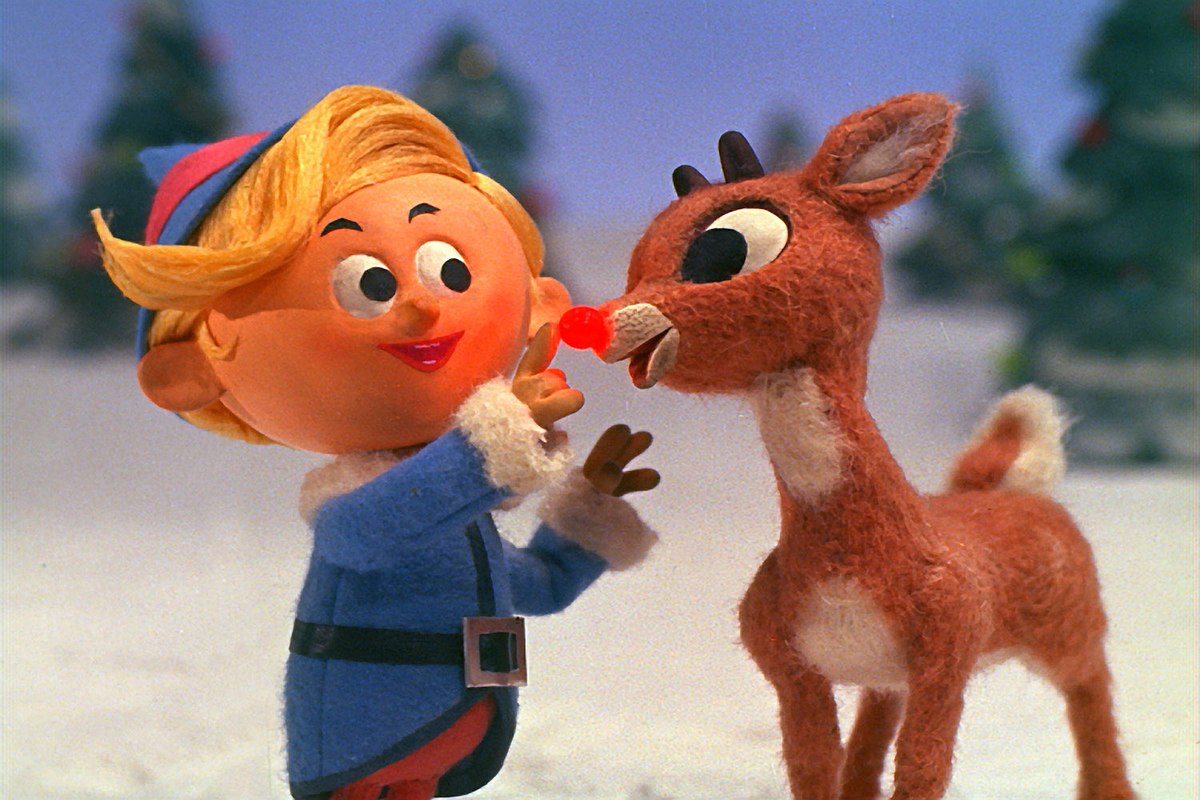Warrensburg, MO. Montgomery Ward had been purchasing and giving away coloring books for customers’ children in their department stores at Christmas-time, but in 1939 it decided to try something new. The company commissioned a story from a copywriter of theirs named Robert L. May and distributed nearly two-and-a-half million copies of the result. What he wrote and they handed out for free was Rudolph the Red-Nosed Reindeer. All these years later it remains instantly recognizable and comprises a profitable staple of the holiday enterprise. My relationship to the reindeer’s story and song is rather mixed, partly due to Rudolph being my father’s first name and my middle, but curiosity about the redemptive theme at the tale’s core intrigued me to delve beyond the surface.
Born in 1905 to a fairly well-off, mostly secular and morally conscious Jewish family in New Rochelle, New York, May grew up in an intensely shy childhood acquainted with the discomfort of being awkwardly different. His intelligence and inquisitiveness led him to Dartmouth College in 1922, and there he was significantly influenced by Austrian psychiatrist Alfred Adler’s work exploring the emotional power of inferiority and the desire for self-assertion as primary motivators within human existence.
Also Jewish, like May, Adler (1870-1937) had grown up knowing similarly pronounced differences from others and because of that went on to pioneer understandings of personality formation in children and what came to be called Individual Psychology. In 1932, he was named the first chair of medical psychology in the U.S.—at Long Island Medical College—even as the growing ideological fascism back home saw that his educational reforms were abolished two years later. Austrian-born Adolf Hitler—himself having growing up in a struggle-marked childhood—eagerly desired ascendancy, and in 1925 he not only terminated his own Austrian citizenship but also published the first volume of his Mein Kampf. By 1933, Hitler was Chancellor of Germany and his book (which had now sold a million copies) appeared in English as an abridged edition; the full edition was published in 1939.
May had been commissioned early in 1939 to write a “cheery children’s book,” but his life was bleak, to say the least. His beloved wife, Evelyn (a social-worker), was extremely ill with cancer. May was mired in debt paying her medical bills while also providing for her and their young daughter Barbara, and he (like many others) was still recovering from losses due to the Great Depression.
Evelyn died on July 28 of that year—the day after her husband’s birthday. May was given the offer of transferring the book project to someone else, but he refused and pushed on—completing it a month later. Imagine the cathartic and cementing bond that formed as May read the developing and completed story to his daughter in the lingering shadow of Evelyn’s death! Drawing from the extended grief of his own childhood and now this palpable loss for him and Barbara, the triumph of Rudolph’s very existence must have been a bright beacon for both of them. It should come as little surprise that the Montgomery Ward recipients of Rudolph the Red-Nosed Reindeer that year resoundingly adored the hope-filled story.
I cannot help but reflect though on how, beyond personal validation, Rudolph’s existential victory can be viewed on a larger scale. Since the late medieval era, the ethnically stereotyped “Jewish nose” grew in popularity as a way of caricaturing an entire people. Julius Streicher, Hitler’s trusted propagandist (formerly an elementary teacher who was later executed at Nuremberg for inciting genocide), published three children’s books between 1936 and 1938 which depicted Jews as despicable and perpetuated the image of the glaring nose as one of the easiest ways to identify them.
Was May demonstrating, knowingly or not, that even the isolated and disparaged—on the very nose of their ridicule—could be pointing the way brightly ahead through a dark and foggy future? Assuming that he was well aware of the increasing indignities and sufferings endured by his much-maligned people in the wider world, I can only think so.
Due to wartime paper restrictions, Rudolph the Red-Nosed Reindeer would not appear in print again until 1946—the year after World War II ended and freed the lingering survivors of those concentration camps. When Christmas came that year, Montgomery Ward handed out a million more copies than the first time seven years earlier—and Rudolph’s triumph must have seemed even greater. As an additional gift, Montgomery Ward granted May total copyright to his story on January 1, 1947. By Christmas of that year, May was able to release the first commercial printing of his book, and by spring of the following year, his brother-in-law, Johnny Marks, had composed the now ubiquitous holiday song, “Rudolph the Red-Nosed Reindeer.”
In 1949, my father (a red-haired, asthmatic thirteen-year-old who wrote to radio and film stars) received a letter from Gene Autry saying that he had a song coming out with my father’s name in it. My father was eager to hear the song and enjoyed the novelty of it at first, but ever after when people heard that his name was Rudolph, the first lines of that song almost always came tumbling out of their mouths. Needless to say, my father (who was steeped in classical music, hymns, and Christmas carols which laud the birth of the Holy Child of Bethlehem) was not very impressed or appreciative. He was Rudy to close friends and family, and later Pastor to most others; the Rudolph went hiding. Born twenty years after the song was recorded, I grew up well accustomed to “the cringe” which accompanied every impromptu rendition people would sing on learning that my middle name was Rudolph.
When my father wrote that letter to Gene Autry, he was a pastor’s son in a Midwestern German farming community four years after the end of the war. Some Americans had looked with derision and suspicion on these people who sent packages to their relatives in Germany and wondered about their fates. When I was that same age, I was wearing a yarmulke every Friday night for our family Shabbat observance in Hebrew and English—which my father instituted because a dear family friend who was a convert from Judaism to Christianity convinced him we needed to do so to honor our Jewish ancestry on his mother’s side . . . and to better appreciate the Jewish roots of Christianity. I’ll never forget the time my Baptist schoolmate spent a Friday night and asked if all Lutherans did that, to which I responded, “No, just us.”
In a strange and blessed way, the name meaning “glory wolf”—most famously associated with that reindeer and the color red—leads me to remember David of Bethlehem, the runt-of-the-family shepherd who knew about wolves and surprisingly defeated the “glory hound” Goliath. Scripture describes him as ruddy or reddish, handsome, and having beautiful eyes (1 Samuel 6:12), but David was also a living reminder that “man looks on the outward appearance, but the Lord looks on the heart” (1 Samuel 6:7); akin somewhat to Rudolph and his experience. David composed the Hebrew psalms out of his personal and communal experience, is the namesake for the graceful star which was used to disgrace his descendants, and is the reason the Holy Child was born in Bethlehem. May we praise that One, born among the animals, who is ever shining his light in the darkness of the world’s night!
Image credit: via Wikimedia Commons




